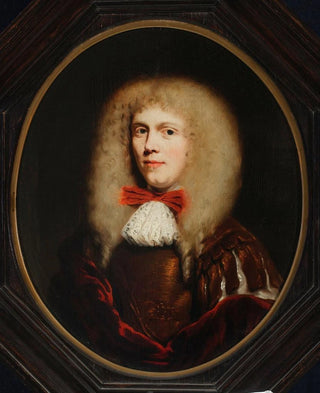Art print | Portrait of a man wearing a wig - Nicolaes Maes


View from behind

Frame (optional)
In the vast universe of art, some works transcend time and space, captivating viewers and inspiring reflection. The "Portrait of a man wearing a wig" by Nicolaes Maes is a quintessential example. This piece, created in the 17th century, stands out not only for its technical mastery but also for the psychological depth it offers. Through this portrait, Maes manages to capture the very essence of his subject, providing the viewer with a window into a bygone era while evoking universal emotions. The art print of this work allows appreciation of the finesse of its execution and the richness of its history.
Style and uniqueness of the work
Nicolaes Maes's style is characterized by striking realism, meticulous attention to detail, and subtle use of light. In this portrait, the artist succeeds in creating an intimate atmosphere, where the depicted man seems both present and distant. The texture of the clothing, the play of shadows and light on the face, as well as the delicacy of the features, testify to exceptional craftsmanship. Maes, influenced by Rembrandt, employs chiaroscuro techniques that enhance the three-dimensionality of the subject, giving him an almost palpable presence. Every element of the composition, from the choice of colors to the posture of the model, is carefully designed to convey an impression of dignity and nobility, making this work a true study of character.
The artist and his influence
Nicolaes Maes, born in Dordrecht in 1634, is often regarded as one of the masters of Dutch portraiture. A pupil of Rembrandt, he mastered his master's techniques while developing a personal style. Throughout his career, Maes created numerous portraits, as well as genre scenes that reveal his interest in everyday life. His influence on Dutch art is undeniable, as he helped establish high standards in portraiture. Artists who followed his path often sought to imitate his realistic approach and his ability to capture the human soul. The "Portrait of a man wearing a wig" is a perfect illustration of his talent, and it continues

Matte finish

View from behind

Frame (optional)
In the vast universe of art, some works transcend time and space, captivating viewers and inspiring reflection. The "Portrait of a man wearing a wig" by Nicolaes Maes is a quintessential example. This piece, created in the 17th century, stands out not only for its technical mastery but also for the psychological depth it offers. Through this portrait, Maes manages to capture the very essence of his subject, providing the viewer with a window into a bygone era while evoking universal emotions. The art print of this work allows appreciation of the finesse of its execution and the richness of its history.
Style and uniqueness of the work
Nicolaes Maes's style is characterized by striking realism, meticulous attention to detail, and subtle use of light. In this portrait, the artist succeeds in creating an intimate atmosphere, where the depicted man seems both present and distant. The texture of the clothing, the play of shadows and light on the face, as well as the delicacy of the features, testify to exceptional craftsmanship. Maes, influenced by Rembrandt, employs chiaroscuro techniques that enhance the three-dimensionality of the subject, giving him an almost palpable presence. Every element of the composition, from the choice of colors to the posture of the model, is carefully designed to convey an impression of dignity and nobility, making this work a true study of character.
The artist and his influence
Nicolaes Maes, born in Dordrecht in 1634, is often regarded as one of the masters of Dutch portraiture. A pupil of Rembrandt, he mastered his master's techniques while developing a personal style. Throughout his career, Maes created numerous portraits, as well as genre scenes that reveal his interest in everyday life. His influence on Dutch art is undeniable, as he helped establish high standards in portraiture. Artists who followed his path often sought to imitate his realistic approach and his ability to capture the human soul. The "Portrait of a man wearing a wig" is a perfect illustration of his talent, and it continues






